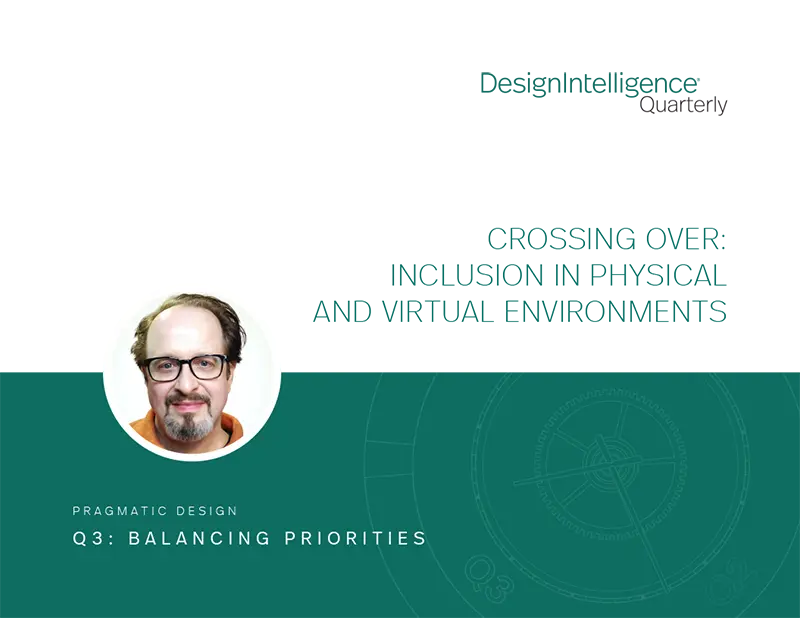Crossing Over: Inclusion in Physical and Virtual Environments
by Bill Curtis-Davidson
Senior Specialist, Cadmus
August 16, 2023
Cadmus' Bill Curtis-Davidson discusses inclusion and accessibility priorities in integrating digital, virtual and physical interfaces and environments.
DesignIntelligence (DI): Welcome, Bill Curtis-Davidson, Senior Specialist in U.S. Public Sector Strategy and Transformation
for Cadmus. You assumed your position in 2020. Can you describe your role, your responsibilities and
the company?
Bill Curtis-Davidson (BCD): Cadmus is a strategic and technical consultancy compelled to help solve challenging global problems with more than 1,000 consultants serving government, commercial and nongovernmental organizations around the world. I joined the company in Spring 2020 to help lead strategic technology policy initiatives for our U.S. federal government clients. I work with teams focused on helping organizations responsibly develop and implement emerging workplace technologies, such as those that leverage artificial intelligence (AI) or immersive/extended reality.
DI: Our theme for Q3 of 2023 is balancing priorities. In your work, it’s the context of making decisions and setting priorities for people in hybrid work. As you integrate new technologies into today’s post-COVID, hybrid workplaces, how do you balance the organization’s needs while creating compelling workplaces where diverse employee populations can thrive? What’s driving this mission, and is there a strategy?
BCD: Over the last three to four years I’ve been involved in helping my clients navigate change through strategic use of existing and emerging workplace technologies to support the shift to remote, hybrid work, with a focus on accessibility and the needs of employees with disabilities. Globally, one in five people have a diagnosed disability, so it’s a sizable population that overlaps with the many other human diversity factors.
This dramatic shift to telework was a boon to employees with disabilities who had long wanted greater location, flexibility and telework options as workplace accommodations. This led to higher employment rates of people with disabilities and helped organizations develop a more inclusive and diverse workforce.
A recent study of Microsoft employees found that the massive shift to remote work created new challenges.1 Collaboration is more siloed and less interconnected, synchronous communication is decreased and it has been more difficult for employees to acquire and share new information in the workplace. This shift brought new accessibility challenges. Many leading telework platforms responded to these challenges by advancing the accessibility of their products, such as offering captions and transcription for virtual and hybrid meetings. The need for remote telepresence also was a boon to immersive or “extended reality” (“XR”) technologies – an area I’ve specialized in – which have been more widely adopted to help employees communicate, collaborate and be co-present with each other in new ways.

DI: What accessibility features of telework platforms help employees with disabilities participate equally in virtual or hybrid workplaces?
BCD: To have an equal opportunity to participate in telework platforms, people with disabilities need to be able to engage in synchronous and asynchronous discussions – as well as with documents and information – in formats accessible to them. For example, having features like automated and human-typed captioning and transcription in virtual meeting tools is important for those who are deaf or hard of hearing, who are neurodivergent and who are language learners. These features are also valuable for everyone as they access information on the go, on multiple devices like tablets and smartphones or when attending meetings in loud or quiet settings. Accessibility features like video pinning can help people who are deaf and lipread and/or communicate using sign language. Video pinning also helps keep an increasingly distributed workforce more engaged in virtual meetings.
DI: You mentioned how XR or immersive technologies are being used in hybrid workplaces to help employees connect and collaborate. How are they being used in physical, built workplace environments?
BCD: XR technologies are beginning to be used more in the hybrid workplace, for meetings and events, training and upskilling, communication and collaboration. There are three main types of XR experiences: Virtual reality (VR) replaces or occludes a user’s reality with a new virtual reality setting, which can be fantastical or practical, such as a training warehouse. Augmented reality (AR) layers virtual content, such as digital objects or information, onto real-world images captured from a device’s camera. Mixed reality (MR) blends the digital and physical worlds, empowering users to interact with both in real time.2 While not yet mainstream, people can access XR content in an increasing variety of ways, including using head-mounted displays (HMDs), web browsers, mobile devices and systems integrated into physical, personal or shared workspaces. As XR technologies mature, we are seeing an increased convergence of physical and digital infrastructures that yield new ways for people to socialize, learn, build, conduct business and provide services.
According to Microsoft, “workspaces are being designed to put remote and in-person workers on equal footing. In the new world of hybrid
work, teams anywhere can collaborate around virtual whiteboards, brainstorm in totally immersive environments and work productively together
at the “office” – whether that’s company headquarters, a satellite location or booked workstation, a cafe or airport, or your own home
or car.”3
Steelcase, a global workplace design and thought leader, has said that “all spaces are now video spaces,” and organizations should offer a range of different spaces and technology experiences and pay attention to three key concepts to enable better hybrid collaboration: equity, engagement and ease.4 Telework and immersive technologies are becoming part of four different types of foundational workspace typologies outlined by Steelcase that support hybrid collaboration, social engagement, personal development and learning.
DI: What are the unique challenges and opportunities of immersive technologies in these four foundational workspace types? What should organizations consider to increase equity and inclusion for workers in hybrid settings?
BCD: All four typologies – collaboration, social, personal and learning – include integrated technologies, so accessibility to them is critical to their successful use. Considerations include how co-located and remote participants enter and move around the space, how cameras and displays provide views of coworkers who aren’t co-located, support for different modes of communication and languages and access to shared digital content placed in physical or virtual spaces.

In recent years, members of the disability community and accessibility experts have described how we must consider disability inclusion and accessibility when designing VR environments or physical environments where XR and immersive tech is more integrated. This can include considering accessibility for people with sensory, physical or cognitive disabilities when designing accessible social VR environments5 – e.g., navigation paths, entrances and exits, functional spaces, task surfaces, social distancing, lighting, audible cues and more. Virtual and physical environments should consider where structural and task surfaces, communication spaces and people (sometimes represented by avatars) will be placed and how all participants can engage in the space regardless of whether they have a disability. We need to think about how someone who is blind or low vision, deaf or hard of hearing, or with a physical disability would enter, understand and participate in the space on an equal footing with others.
DI: So many considerations in designing tech-infused hybrid workspaces, whether virtual or physical. What else shapes thinking about how people – with and without disabilities – can communicate and collaborate effectively once they access the spaces?
BCD: A few years ago, Steelcase, in partnership with G3ict (the Global Initiative for Inclusive Information and Communication Technologies) published the report “Blueprint for Inclusive Workplaces of the Future.” It posited: “Workplaces of the future must be compelling destinations where every team member can contribute – not despite their unique identities – but because of them.”6
As we adapt our hybrid workspaces to integrate immersive technologies, directly engaging people with disabilities in the planning, design and development of the spaces is critical and will benefit everyone. Designing with access for people who are deaf in mind will help the audible components of hybrid spaces – spoken discussions, presentations, audible cues – be accessible to everyone, including people who are neurodivergent or language learners. Sharing digital content that can be accessed in visual, descriptive/audio or textual form will help everyone participate.
Community efforts like XR Access are engaging the talents and perspectives of people with disabilities to explore the connection between inclusively designed XR and effective hybrid work. In a recent report, XR Access’ Business Case for Inclusive XR workstream assembled a diverse research team and conducted independent research on a variety of mainstream and newer startup technologies used in hybrid work settings. The resulting report offers research questions, recommendations and perspectives from actual disabled users to help guide us on a path toward more inclusion.7
We are making progress but still have much to do. The priorities are changing daily.
Bill Curtis-Davidson is a senior specialist at Cadmus and an experienced change agent, inclusive product designer and technology accessibility program lead with a stellar track record of over 20 years in the field. He focuses on complex and emerging technologies (such as AI and AR/VR/XR). In addition, Bill brings unique expertise in program design and management, user research, inclusive design methods, accessible product innovation, quality management and maturity modeling.
Culture and team building are central to Bill’s success. He ensures clear communication at all levels while motivating and inspiring team members, uniting teams and helping them envision and develop creative solutions to challenging problems. Through this approach, Bill has become a trusted adviser and advocate for disability inclusion and accessibility. He supports numerous public and private sector efforts to develop accessibility standards, guidelines and best practices.
Bill is a ForHumanity Certified Auditor (FCHA) and Fellow who helped develop the first version of the ForHumanity Disability Inclusion & Accessibility audit scheme and co-developed and co-taught ForHumanity’s auditor training course on the same scheme. He serves on the External Advisory Board of the Georgia Tech Human-Computer Interaction (HCI) Degree Program and is a volunteer mentor in the LGBT Tech PATHS Program, whose goal is to inspire and empower LGBTQ+ youth and young adults interested in careers in science, technology, engineering, arts and mathematics (STEAM) fields.
In June 2023, Bill was invited to become a member of the Partnership on AI’s Global Task Force for Inclusive AI.
FOOTNOTES:
1 Longqi Yang, David Holtz, Sonia Jaffe, et al., “The Effects of Remote Work on Collaboration among Information Workers,” Nature
Human Behavior 6 (2022): 43–54. https://doi.org/10.1038/s41562-021-01196-4.
2 “XR Use Cases Fact Sheet: Inclusive XR,” XR Association, accessed May 22, 2023,
https://xra.org/wp-content/uploads/2021/02/XRA_Slicks_Accessibility_V3.pdf.
3 “How to Reimagine Workspaces for the Hybrid Era: The Right Mindset Can Enable Equal Access for Everyone,” Microsoft WorkLab,
accessed May 15, 2023, https://www.microsoft.com/en-us/worklab/reimagine-work-spaces-for-the-hybrid-era.
4 “Collaboration in the Hybrid Workplace: A Guide for Designing Spaces to Support In-Office and Remote Collaboration,” Steelcase,
2021, https://info.steelcase.com/hubfs/Steelcase-Hybrid-Collaboration-Guide.pdf.
5 Thomas Logan, “Constructing an Accessible Social VR Environment: Interview with Pablo Cárdenas,” Equal Entry, February 15,
2021, https://equalentry.com/constructing-an-accessible-social-vr-environment/.
6 “Blueprint for Inclusive Workplaces of the Future: Ho w to Create Inclusive, Safe, and Compelling Workplaces,” Steelcase and
G3ict, 2021, https://www.steelcase.com/research/articles/topics/people-planet/blueprint-inclusive-workplaces-future/.
7 “The Value of Inclusively Designed XR Workplace Tools,” XR Access, August 11, 2022, https://xraccess.org/bcxr-report/.


